#monochamus scutellatus
Explore tagged Tumblr posts
Text

White-spotted Sawyer Beetle - August 2023 While at Wrangell - St Elias National Park, I overheard a group of people saying, “Ewww, that’s one of those long-horned beetles that is killing all the trees.” They were about to squash it when I said, “That is not a long-horned beetle.” That led to a quick discussion while two of them looked up long-horned beetles on their phones and I looked up “beetle with white spot on back.” They held up their phones and said, “See!” I held up mine and said, “A long-horned beetle doesn’t have the white spot.” They said “Oh,” and didn’t squash this rather nice-looking White-spotted Sawyer Beetle. Both beetles lay eggs in pine trees, but the Sawyer doesn’t carry the disease that kills the trees I can identify long-horned beetles because I found one on a trail in Canada several years ago and didn’t know what it was until we checked into our next campground. There was a big poster with warnings about invasive insects and there it was with its own corner. I said, “I just saw one of those on the trail.” The ranger nicely told me that they had been eradicated in the area. I didn’t argue, but after we set up, I brought back my laptop and showed her the images I had taken of a long-horned beetle sitting on a fallen tree. She called her supervisor and reported it. I don’t know what he said, but she responded, “He’s got pictures.” I ended up burning a disk for them of my entire hike so they would know exactly where I took the picture. A week later, we heard on the news that a section of forest had been intentionally burned to eradicate long-horned beetles. It was the trail I had been on. MWM
#alaska#tok ak#valdez ak#wrangell - st elias national park#pine sawyer beetle#monochamus scutellatus
0 notes
Text
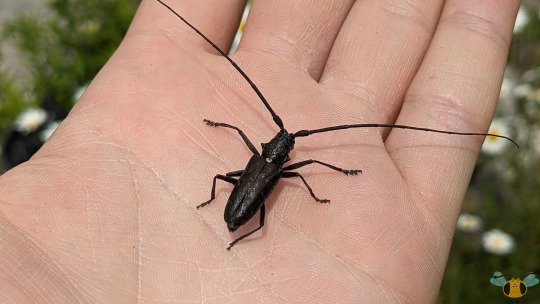

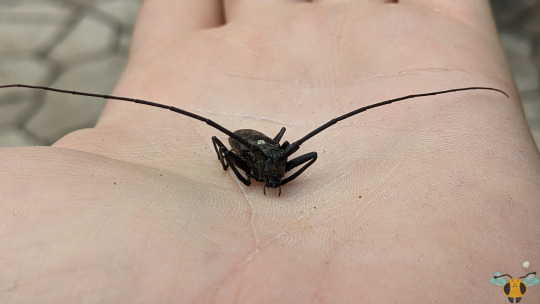


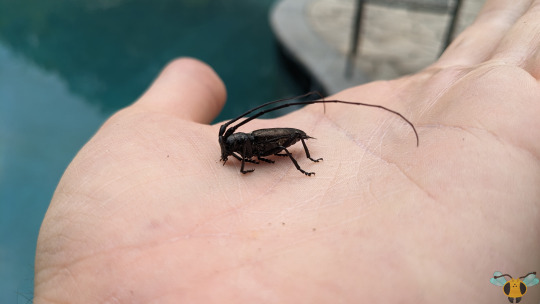



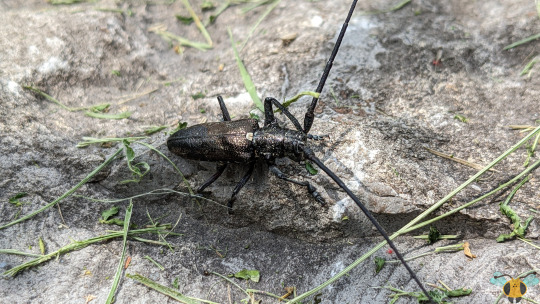
Whitespotted Sawyer Beetle - Monochamus scutellatus
This insect has already been thoroughly examined and explored in the previous post that featured it. For today's post, please enjoy a few more pictures of this hardy Longhorn Beetle that survived a tumble into a cottage pool thanks to quick intervention. If you seek one in North America, remember the following tidbits of information:
Since it relies on forests for its diet and egg-laying, search there to try and find live specimens. Check the bark and needles of cut/damaged pine, spruce and other conifer trees. They are attracted to the scent cues and may also be found after fires (but please don't look during a fire, be safe)
It is a native North American insect, and so the ecosystem has had plenty of time to adapt to it, and the Beetle itself doesn't appear to have status as a major pest of trees
To identify it and distinguish it from its relatives, look for a white scutellum (between the wingcases) and pronotum "shoulder" spikes. It is also rather slim with a slightly widened abdomen
The elongated antennae are hard to miss; they are easily 2-2.5 times the length of the body. Oh my!
If the antennae are ringed and/or the wingcase features white patches, the specimen is something else...something far more invasive (see the Citrus Longhorn for details)
The larvae may be trickier to find since they hid beneath trees, but they are apparently noisy, hence the name "Sawyer"
The adults have formidable jaws as well, but are unlikely to do anymore than pinch. Nevertheless, handle with care
I really enjoyed observing this insect during the summer of last year, and I'm glad it could be saved from a pool. It still needed some time to recuperate before it could move again, but Beetles are very durable and resilient! I'm very fond of Picture 2, where it looks like the Beetle is trying to pull itself up again, but is too exhausted to fully stand. It tries anyway. I didn't pose it that way, that's just the way it landed on the nearby stones. For a general timeline of handling this insect from the pool: hand pictures first, stone pictures afterwards with Pictures 7 and 10 showcasing the Beetle having regained its strength to begin move again.
Pictures were taken on July 1, 2023 in Caledon with a Google Pixel 4.
#jonny’s insect catalogue#ontario insect#beetle#whitespotted sawyer beetle#longhorn beetle#whitespotted sawyer#coleoptera#insect#caledon#july2023#2023#nature#entomology#invertebrates#arthropods#animals#photography
15 notes
·
View notes
Text
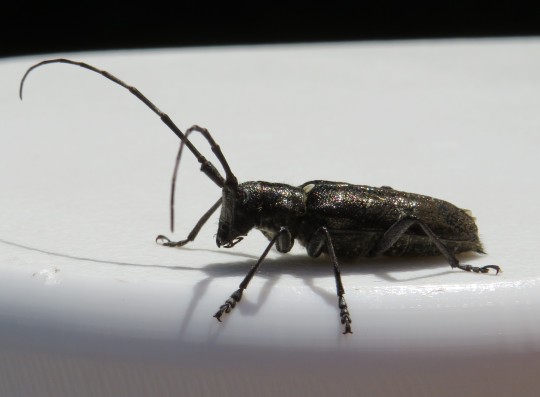
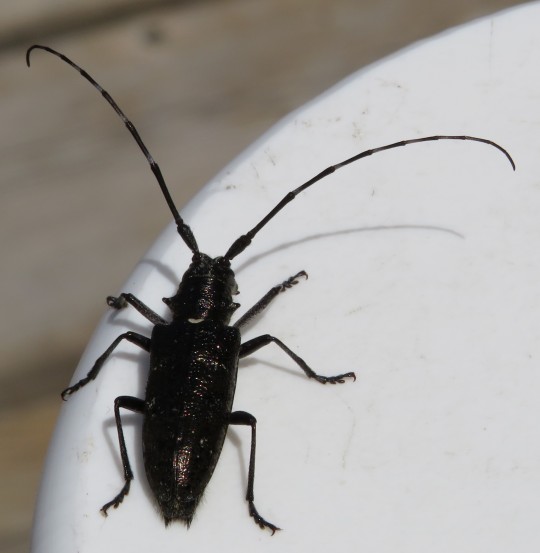
Monochamus scutellatus (male)
#White-spotted Sawyer Beetle#spruce bug#canada#my photos#ecology#native species#nature photography#wildlife#nature aesthetic#summer 2022#insects#bugblr#beetle
5 notes
·
View notes
Text

@carys-the-ninth
That's the them
It is 92 degrees. Swix just ate one of those things that I thought was a spruce bark beetle but is apparently not so I don't know what they are. They bite. It took him a while to figure out he couldn't just lick it to death and that it was too chunky to smash with a paw.
To be perfectly fair, he is wrapped up in double black velvet so if he fires up the synapses on his three dented secondhand braincells he will overheat his little kitty skull. As a reward for his hunting prowess he is napping in the shade. Life could be worse.
39 notes
·
View notes
Text
monochamus... scutellatus? oregonensis?? I saw on a hike earlier this week :]

a cool guy
#monochamus scutellatus#white-spotted sawyer#bugblr#I literally only saw him bc I was looking for the thing making that creaking noise and he happened to be right next to it!!#didn't find what animal or whatever was making the sound tho. heard it a lot
7 notes
·
View notes
Photo
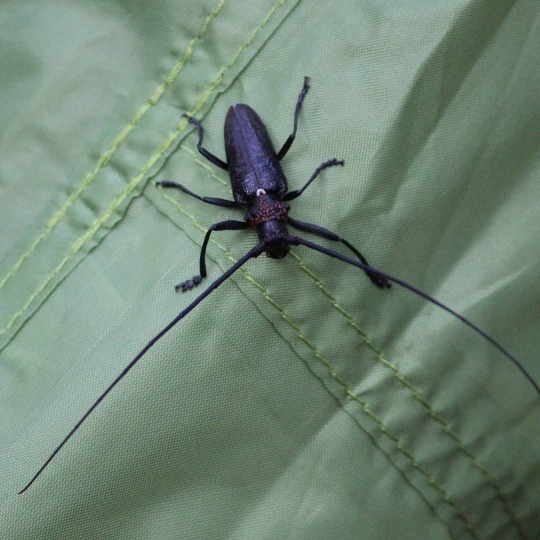
White-Spotted Sawyer Longhorn Beetle (Monochamus scutellatus) in Algonquin Provincial Park, July 2017. This individual is a male, as evidenced by the extremely long antennae (The "longhorns" of its common name). There are tiny red Mites hitching a ride on this Beetle as well. The mites are possibly of the genus Trichouropoda, and so far as I can find, we're still not exactly sure why they do this. It's likely they ride on these wood-boring Beetles to reach new habitats faster. They don't seem to be harmful to the Beetles unless there's a particularly large number of them. . . . . . . . #nature #ontario #symbiosis #phoresy #mites #phoretic #phoreticmites #monochamus #monochamusscutellatus #cerambycidae #cerambycidaebeetle #longhornedbeetle #beetlesofinstagram #woodboringbeetle #algonquinprovincialpark #algonquinpark #ontarioprovincialparks #ontarioparks #ecology #insectecology #arthropods (at Algonquin Provincial Park) https://www.instagram.com/p/CCiq-BJpxCO/?igshid=4xe3u6yche3k
#nature#ontario#symbiosis#phoresy#mites#phoretic#phoreticmites#monochamus#monochamusscutellatus#cerambycidae#cerambycidaebeetle#longhornedbeetle#beetlesofinstagram#woodboringbeetle#algonquinprovincialpark#algonquinpark#ontarioprovincialparks#ontarioparks#ecology#insectecology#arthropods
1 note
·
View note
Text

Reproduction and mate choiceEdit
As with many other insects, both intraspecies and interspecies competition occurs in M. scutellatus over resources. Hughes and Hughes[10] performed experiments to test the results of asymmetric contests of M. scutellatus and M. notatus, the eastern pine sawyer. They found that in M. scutellatus, females laid eggs that were fertilized by the male with whom they were currently sharing a pair-bond with, and the certainty of paternity decreases once the pair-bond is over. Consequently, females are the most valuable resource that males compete over.
As for the females, the majority of their inter- and intraspecies competition was over oviposition holes. Female M. scutellatus individuals often spend over 20 minutes using their mandibles to chew oviposition holes in the bark of trees, which makes a very loud noise and incurs substantial risk of detection by predators.[10] Therefore, it is greatly advantageous for females to steal holes chewed by other females to save time and risk.
The study found that both within and between species, contests between larger resource holders and smaller challengers usually do not escalate and the resource holder retains their territory, but contests between smaller resource holders and larger challengers are more likely to escalate to fighting with the pro- and mesolegs and biting of the legs and antennae. This is likely because Monochamus species have large, strong mandibles which are capable of biting off limbs or antennae, and escalated competitions are usually not worth the risk.[10]
M. scutellatus displays resource-defence polygyny, a mating system in which males defend necessary resources that females require for reproduction.[9] Resources in this case refer to the quality of tree trunk that the male has won; females prefer basal trunk regions with a large diameter.[8] Females then choose mates mainly on the basis of their resources, but when resources are equal, Hughes and Hughes[9] observed that they choose larger males preferentially. Although it has not been proven that large body size is inherited by offspring, it still may be an indicator of fitness and quality.
0 notes
Photo

These beetles were everywhere, and apparently they bite really hard, but I was nice to him, and he was nice to me. 😊 The White-Spotted Sawyer, (Monochamus scutellatus) is from the family Cerambycidae (the long-horned beetles). 🐞🐞🐞🐞🐞🐞🐞🐞🐞🐞🌲🌲🌲🌲🌲🌲🌲🌲🌲🌲#monochamusscutellatus #whitespottedsawyer #beetle #beetles #blackbeetle #longhornedbeetle #northern #saskatchewan #canada #southend #exploring #explore #photography #insect
#explore#exploring#beetles#photography#longhornedbeetle#beetle#saskatchewan#insect#canada#whitespottedsawyer#monochamusscutellatus#northern#southend#blackbeetle
4 notes
·
View notes
Text

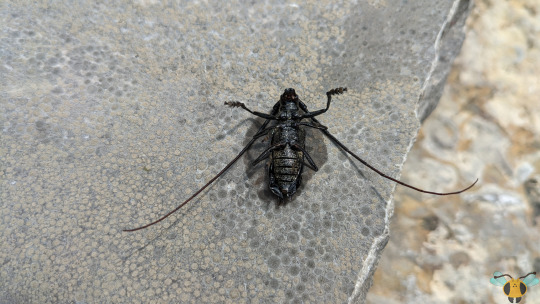



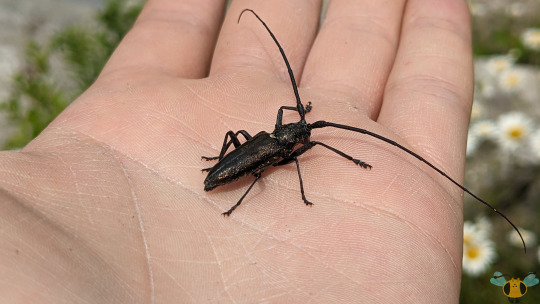




Whitespotted Sawyer Beetle - Monochamus scutellatus
Here it is, the final new insect specie from Caledon! It's among the largest of its family that I've had the privilege to see (and hold) in person. Things weren't looking good initially as I found it floating in the pool, motionless, but I plucked it out of the water* and placed it onto dry land. This lucky Longhorn wasn't the only arthropod to be saved from the pool that day; there was a young Carolina Locust, a Backswimmer and a mother spider carrying dozens of spiderlings on her abdomen! The prospect of water can seem attractive to an insect...until it falls in, or worse: an aquatic insect snares them as they struggle! Fortunately for the arthropods of this pool, they all got to live another day, but I wasn't sure what would happen with this specimen. Fortunately, there was still life left in it and after some heat from the sun and hot stones, it begun to move! Gently picking it up to be sure, I was overjoyed to see the Beetle begin to stir, regain its footing and slowly move again. All this is a testament to the design of the respiratory and circulatory systems insects and their efficiency/management of their gas exchange. Spiracles can be shut when things get difficult and oxygen can be conserved if metabolic energy and exertion is reduced.
In this situation, with escape by swimming, flying or landfall unlikely (but possible), the tracheae stay water free and breathing be can held off until conditions are favorable, but only up to a point. The cold water may have also helped this process along by slowing down the metabolism. However the factors lined up, with a gentle hand, this Beetle received a second chance to return to the forest and the many trees within it! The adults enjoy feeding on pine and spruce trees or similar conifers, and use those large mandibles (see Pictures 7 and 8) to get the job done. Though they appear fearsome, they are strictly vegetarians and deliver far less than a pinch when handled. The larvae of these Beetles also feed on conifer trees, but only by boring into the innards of dead or dying trees. Furthermore, there is a significant amount of the research attributed to the larvae becoming active after forest fires due to the presence of dead wood and a lack of competition for it. The adults do their best to set up those ideal feeding conditions by chewing openings into dying trees or fallen logs and depositing their eggs there. The rest is up to nature. However, there have to be fresh trees nearby to fit the dietary needs of the adults. If not, wings will carry them wherever their antennae sense adequate food.
They sure do have looooong antennae! They are easily two or two and a half times the length of the Beetle's body at full extension! The antennae are prominent, and useful for identifying this Beetle, but the first features you should look at for identification are the scutellum and the sides of the thorax. The former usually has a white color (like a spot) and the latter has a pointed spike on each side (see Picture 1). You may find specimens with faded white patterns on their shells too, but this is normal for this specie. What you should be aware of (especially if found in Ontario) is if they have spotted wingcases and black and white ringed antennae, as those are key features of the Asian Longhorn Beetle (Anoplophora glabripennis), a similar looking invasive pest (for reference on this blog, see the Citrus Longhorn Beetle - A. chinensis - a close relative). While the Whitespotted Sawyer can also inflict damage to trees, it is native to North America and the ecosystem is well adapted to their activity. Though A. glabripennis is reported to be successfully eradicated in Toronto and Mississauga, treat any large similar-looking Longhorn with a bit of scrutiny. To conclude the story, this individual was feeling ok at the end of the day. After 10-15 minutes in the sun and beginning to move again, it was placed on stones closer to the forest and allowed to go about it's way. It's likely after a few minutes more of warming up and shaking off any remaining water, it could fly back into the trees.
*Note: Treat any insect/arthropod you find a swimming pool or body of water with caution. There's a chance they may be alive and/or agitated and may fight back. DO NOT handle an animal unless positively identified as safe (especially with spiders). Preferably use tools or objects to get them to the safely of land or use a container or net. Finally, if you rescue a land insect from water and it rushes back in, it is likely parasitized. Fish it out with pool equipment, then throw it away and avoid "wormy" looking insects.
Pictures were taken on July 1, 2023 in Caledon with a Google Pixel 4.
#jonny’s insect catalogue#ontario insect#beetle#whitespotted sawyer beetle#longhorn beetle#coleoptera#insect#caledon#july2023#2023#nature#entomology#invertebrates#arthropods#animals#photography
1 note
·
View note
Photo

Monochamus scutellatus, aka. white-spotted sawyer or spruce sawyer, is one of several long-horned beetles. My dad caught this one for me. He gets them flying into his garage during the evening in the summer. These big fellas chew holes in pine and spruce trees and spread fungus, raising hell with the logging industry.
1 note
·
View note
Text

it looks like Monochamus scutellatus but its antennae are wrong???
i was having a dissociative episode and then my friend sent me a bug pic and i was struggling to ID it so much and getting so angry about it that it pulled me out of the dissociation. my autism is so powerful
5 notes
·
View notes
Text
I know your musty dusty greasy ass isn't talking when you look like a literal monochamus scutellatus. And I know the abnormal growth in your antennae aren't healthy; get it checked out girlie!

@oobledooblee Your eyes are escaping.
9 notes
·
View notes